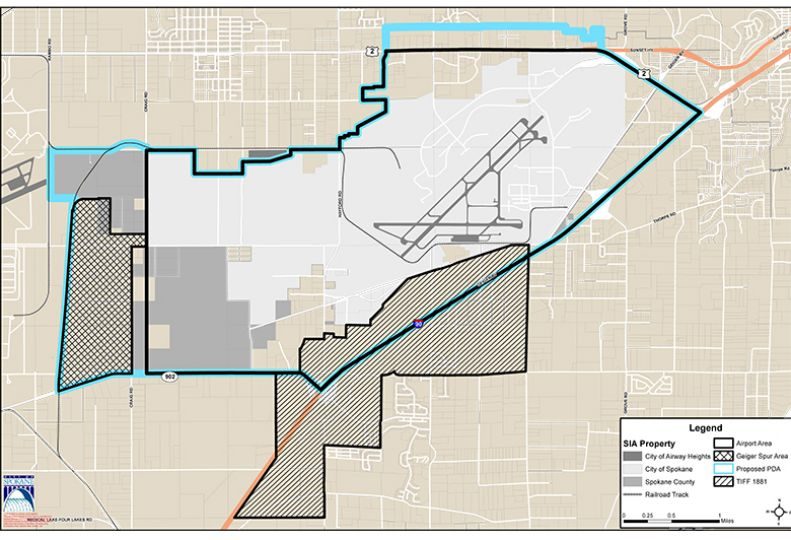
Home » Rail facility project likely to relocate to new airport PDA
Rail facility project likely to relocate to new airport PDA
Long-planned transload site deemed too close to Fairchild

August 31, 2017
One of the first infrastructure projects under consideration for the recently formed West Plains Public Development Authority might be the long-envisioned transload facility, says Spokane County Commissioner Al French.
The facility won’t be located, however, on the portion of the Geiger Spur where it was being envisioned until recently, French says.
A transload facility allows for efficient transferring of freight between rail cars and trucks.
Spokane County had issued a request for proposals for a transload facility to be constructed along a portion of the Geiger Spur west of Spokane International Airport, near the eastern edge of Fairchild Air Force Base.
French says the county decided to reject that site due to new concerns raised by Fairchild.
“The reason for the relocation has more to do with protecting Fairchild than anything else,” he says.
The county earlier had estimated a complete facility would cost upwards of $4 million to construct.
The county now is in talks with Spokane International Airport to locate the transload facility project on a portion of the Geiger Spur that’s farther away from Fairchild and within the airport property.
“We met with the airport and delivered all the information we have so they can pick up the ball and put it on the airport part of the Geiger Spur line,” French says.
He says the airport so far is receptive to the idea.
“There’s no question it’s needed,” French says. “Now it’s a matter of finding the best location with the greatest amount of economic development opportunity.”
Despite what might appear to be a setback regarding the long-planned transload facility, French asserts that it might become a reality sooner as part of the West Plains PDA.
“I think it’s closer to reality,” he says.
Spokane County, the city of Spokane, and Spokane International Airport announced the formation of the West Plains PDA in July.
The PDA’s district includes the airport and some bordering property surrounding it.
The city of Spokane and Spokane County jointly own the airport, and portions of the PDA are in the city of Spokane and in unincorporated portions of the county.
Under the 20-year PDA agreement, the city and county will allocate 75 percent of incremental increases in tax revenue generated within the boundaries of the district to the PDA. The city and county also will jointly back future debt of the PDA, which will have bonding authority to fund infrastructure projects.
The West Plains PDA is intended to target new manufacturing and aerospace development to grow and attract jobs here, while the airport master plan also calls for attracting added transportation and logistics services.
“I’m personally talking to three different companies that have expressed interest in the West Plains,” French says. “One is a manufacturer. Another is in distribution, and another is in aerospace. Some incentives this PDA will offer will make it more attractive.”
The West Plains PDA is the first joint effort of its kind between the city, county, and airport, although Spokane has formed PDAs in the University District and in Hillyard previously.
The state Legislature has allocated $2 million to construct a new rail spur that will come off the Geiger Spur and loop onto the west-central airport property within the new PDA.
The rail line will be in the design phase this winter and likely will be constructed next year, French says.
“It would be great to have the (transload facility) construction at the same time,” he says.
While the county originally had contemplated developing the transload facility in two phases, French says the PDA might make it feasible to construct it in a single phase.
“We’re just starting to put packages together seeking grant money from a variety of sources,” he says, adding, “The PDA offers some attributes not available to a straight county project.”
Spokane International Airport CEO Larry Krauter says he’s anxious to see the PDA developments come to fruition, including the transload facility.
“We’re working on a couple of different ideas,” Krauter says. “The county has done some planning that we’re going to take full advantage of—particularly with the layout.”
He says the airport is considering a transload location on part of the rail project so that funding could be taken on by the PDA.
Additional site analysis is needed, but it’s looking like an ideal site would be somewhere west of the airport, close to the intersection of McFarlane and Hayford roads, Krauter says.
“We have a thorough and sophisticated aerospace recruitment strategy for our region,” he says, adding that many such prospects ideally would be located in and around the airport.
In the long term, the PDA will help develop the infrastructure needed for such businesses to grow organically or to attract new aerospace, manufacturing, transportation, and logistics companies, all of which will dovetail with the airport’s master plan, Krauter says.
From the airport’s perspective, the PDA also will support retention of existing air service and attract additional air service to the benefit of the Spokane economy.
For instance, Southwest Airlines announced this week that it will offer daily flights between Spokane and San Jose, Calif., starting next spring.
“That will provide nonstop connection to Silicon Valley,” Krauter says. “I think it’s going to be a big potential for economic development.”
Latest News Real Estate & Construction Government
Related Articles
Related Products




